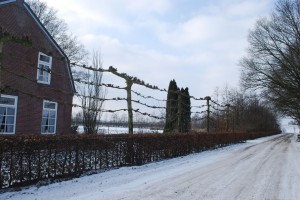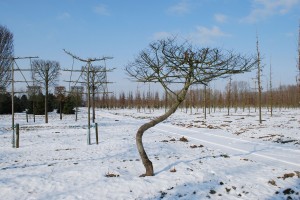I have just come back from the Netherlands where I visited Van Den Berk tree nurseries to choose and tag some semi-mature trees for a project we have in Hertfordshire. Something of a circulatory in all of this being one of the last projects I shall put on the ground for Terra Firma before returning to Lithuania (and more about that another time). When I first started here 8 years ago Lionel was keen I obtained some practical horticultural experience to compliment my architectural degree and referred me to Hilliers where I worked Part Time in their big tree nursery while also starting at Terra Firma. So I am very familiar with the large tree transplanting process and how very satisfying it is! Here I had the chance to appreciate a lot of topiary, grafted, pollarded, pleached trees as well as witnessing the context of neat and carefully arranged private gardens and communal landscapes. This all, I guess, matches the country’s attitude towards land – if something is needed, that does not exist, they can build it, and make it look good too.

Any theme or style I saw, did not strike me as being overly used and repeated across many gardens (if pollarding and pleaching trees as well as topiary is not considered) or have a unifying style, except that one that could be associated with the country’s overall look.
But then speaking to a nurserymen , a different story behind those gardens becomes apparent. People are very responsive to fashion trends when buying trees, therefore nursery stock is very much affected by this. Amongst trees considered as a matter of fashion there were cedars (currently not en vogue), ornamental trees, horse chestnuts, even oaks!
When designing in UK, trees are rarely something I would consider as a fashion element, although it probably is among the garden design fraternity. We are more likely to be swayed by latest information on climate change or disease resistance. It is the ornamental shrubs, grasses, shapes and materials that are easily associated with trends in garden design, rather than magnificent trees, such as cedars and oaks, which to my mind are the legacy of stability in the surrounding changing world – quite opposite to the dynamics of the fashion. Interestingly, I recently came across the article in Garden design magazine, where Tim Richardson was also investigating the rationale behind the trends in gardening and concluded that ‘it is about the state of mind’, and each country has its own of course.
For the above reasons (and no doubt many others) the way Dutch people shape their landscape is different to typical British landscape scenery – what a good way to appreciate different Genius Loci when travelling. Nevertheless the landscape in Netherlands is inspiring with it’s neat shapes, uniform tree avenues (made of poplars that are planted with intention to be chopped eventually) and a close attention to detail that I find very appealing.
Lastly, my discovery of a tree was the ‘swing-tree’, which is intended to be popular in the garden schemes (platanus hispanica, roof-top shape – see pic). It takes good 12 or so years to shape it to look this way. The fashion better not change faster than that!
